The goal of this portion of the project was to create frac sand mining suitability and environmental/cultural risk models for Tremeapleau County using geoprocessing tools and model builder. Each model accounts for several important factors, and when joined together, the two models can be used to create a single model for determination of ideal mining locations.
Suitability Model
Objectives
The objective of the sustainability model was to create layers that account for/rank geology, land cover, distance to the nearest railroad station, slope, and water table depth according to their effect on the suitability of a region for frac sand mining. The rankings associated with each layer were combined, creating a single, comprehensive suitability index model. Additionally, any area with land use unsuitable for mining was removed from the ranking.
Data Sources
Data came from a variety of sources, which included past project work, as well as publicly accessible data sets. County/state and bedrock geology data were provided by the professor. Land cover data was downloaded from the NLCD website, rail loading points were generated, and an elevation raster was created in class for exercise 4. Water-table information was downloaded from the Wisconsin Geological Survey.
Methods
The first step for each layer was ensuring they were in the correct projection (Fig. 6). I used the county projection system specific to Trempealeau (NAD_1983_HARN_WISCRS_Trempealeau_County_Meters). For the geology layer, I had to convert the initial polygon features to a raster and reclassified the values. Because the Jordan and Wonewoc are the only formations suitable for frac sand production, they were given a value of 1. All other formations were given a value of 0, indicating no potential for frac sand mining (Fig. 1).
 |
| Figure 1. The Wonewoc and Jordan formations (Ew/Ej) were reclassified as the only geologic units desirable for frac sand mining. |
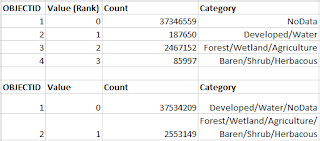 |
| Figure 2. The top table was used to rank land cover based on suitability for mining. The bottom table was created to allow for the removal of developed and water filled areas from the model. |
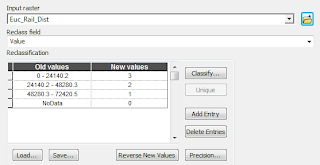 |
| Figure 3. Reclassification of euclidean distance data (in meters) for rail loading points. |
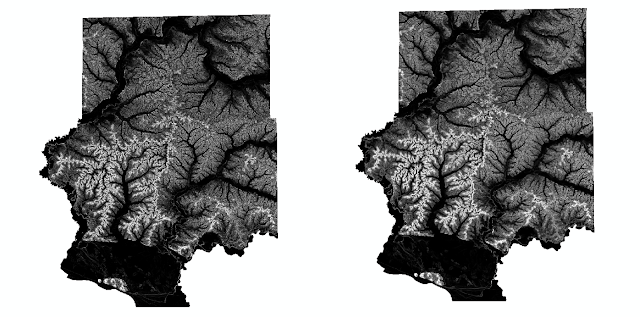 |
| Figure 4. The original slope raster (left) and the smoother slope raster generated using block statistics (right). |
 |
| Figure 5. Water table elevations (old values) were used to classify the suitability of areas for frac sand mining based on the availability of water. |
 |
| Figure 6. A model for determining frac sand mining suitability based on geology, land cover, rail distance, slope, and water table depth. |
Environmental/Cultural Impact Model
Objectives
The objective of the sustainability model was to create layers that look at the effect on streams, agriculture, residential areas, schools, and parks based on proximity to mining locations. The values from each layer were divided into three categories 1 (low impact), 2 (med impact), and 3 (high impact). The rankings for all the layers were combined, creating a single, comprehensive risk model. Additionally, any area within 640 meters of residential locations (noise/dust shed) was removed from the model.
Data Sources
Data for this portion of the project came from two different sources. Stream and land use data was downloaded from the DNR website. Residential, school, and park locations were provided by ESRI. Populated places (ESRI) was used for residential data. This data is beneficial in that it focuses on main population centers. However, it does not adequately account for rural homes that tend to be more isolated.
Methods
As in building the suitability model, the first step for each layer was ensuring they were in the correct projection (Fig. 10). To stay consistent, I again used the county projection system specific to Trempealeau (NAD_1983_HARN_WISCRS_Trempealeau_County_Meters). For the stream data, I removed the overland flow categories, as overland flow is considered runoff rather than stream flow in the hydrogeologic community. Beyond that, the processing of most layers stayed similar. Euclidean distance was used to generate four rasters showing the distance from each cell to streams, populated/residential areas, schools, and parks. Possible mine locations close to features were assigned values of 3 (high impact) while those further separated were given value of 1 (low impact) using the reclassify tool.
Land cover data was evaluated differently because the concern is for farming potential of potential mine locations rather than proximity (Fig. 7). Croplands or areas that are already being used for agriculture were given a value of 3 (high impact). Forested and vegetated areas that had the potential to be turned into farm land, which were the majority, were given a value of 2 (med impact). Developed areas and those with open water were given a value of 1 (low impact) as they are very unlikely to be used for agricultural purposes.
 |
| Figure 7. Land cover data was reclassified based on farming potential (LABEL). |
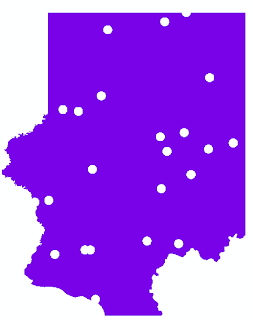 |
| Figure 8. 640 meter buffer areas (white, circular holes) were removed from the model around populated locations. |
As a side project, the viewpath tool was run to determine if any mining locations would be visible from the Arcadia Country Club (Fig. 9). Clearly, visibility extends miles beyond the actual site. This likely indicates a frac sand facility in this area would alter the scenery, even from significant distances.
 |
| Figure 9. Visibility clearly extends several miles away from Arcadia Country Club (lime green) in all directions. |
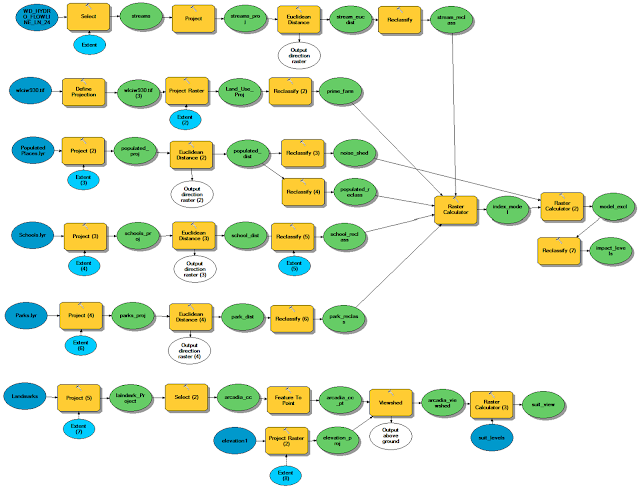 |
| Figure 10. A model for determining the environmental/cultural risks associated with frac sand mining locations. |
Overlay (Combined) Model
Objectives
The objective of the overlay model was to combine both the suitability and risk models to determine ideal locations for frac sand mining that pose minimal environmental/cultural risk.
Data Sources
Data came from the suitability and risk models, which were based on the various sources described earlier.
Methods
As all data was in the correct projection, no additional projection was necessary (Fig. 11). In order to find areas with high suitability and low risk, the risk model was reclassified so that low risk areas were assigned higher values and high risk areas lower values (flipped from original). The values of the two models were then multiplied together to determine potential for mining. The highest potential areas had a value of 9, and the lowest potential areas had a value of 1. The combined values were then reclassified into three categories (high potential, medium potential, low potential) using Jenks' natural breaks (Fig. 16).
 |
| Figure 11. The final combining of both the suitability and risk model into a single model for determining ideal frac sand mining locations. |
Results
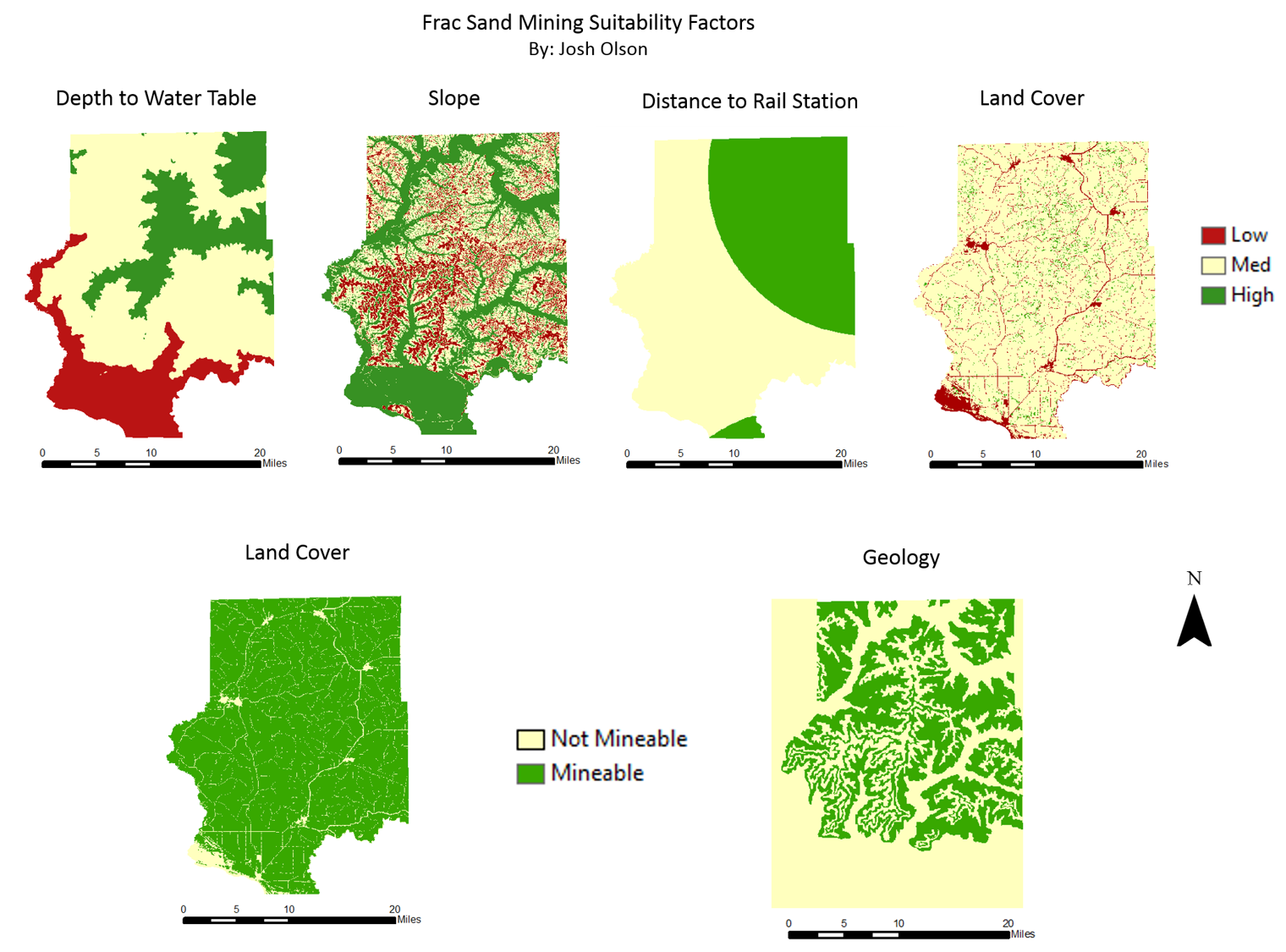 | ||
|
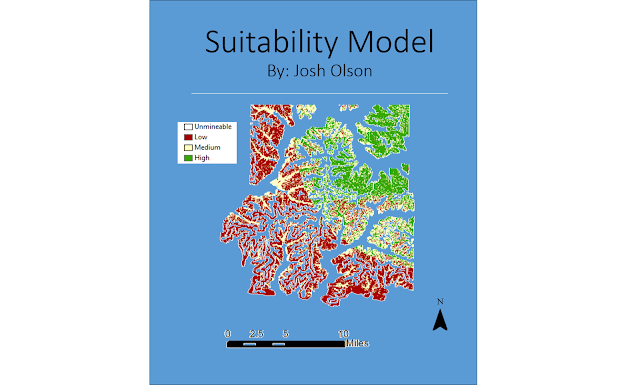 |
| Figure 13. Suitability model created by summing the various suitability factors. |
 |
| Figure 14. Maps of risk factors ranked high-low risk (top) and mineable/not mineable (bottom). |
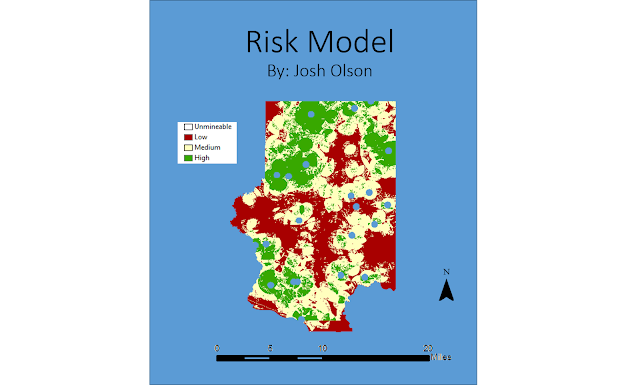 |
| Figure 15. Risk model created by summing the risk factor values. |
Conclusions
This exercise was valuable because it demonstrated the importance of looking at all the factors in a situation when drawing conclusions. Though each individual suitability/risk factor presented some bit of information, the big picture was rather unclear when looking at the mass of individual factors. However, by using geoprocessing tools and raster functionality, the individual factors were combined into useful information. In this case, the potential of the northeast portion of the county for mining is apparent. It would be interesting to see how the data would change if an additional rail location was added in the county, as it one of the more alterable factors in the model. Overall, the models demonstrate the potential of GIS to assist in decision making in a multi-million dollar industry.
Sources
WDNR - ftp://dnrftp01.wi.gov/geodata/
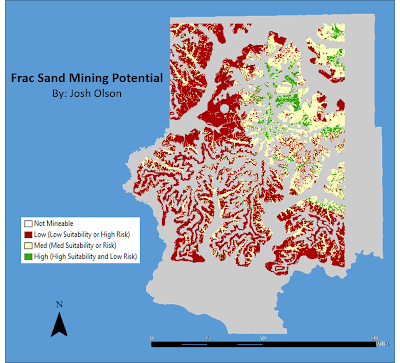
No comments:
Post a Comment